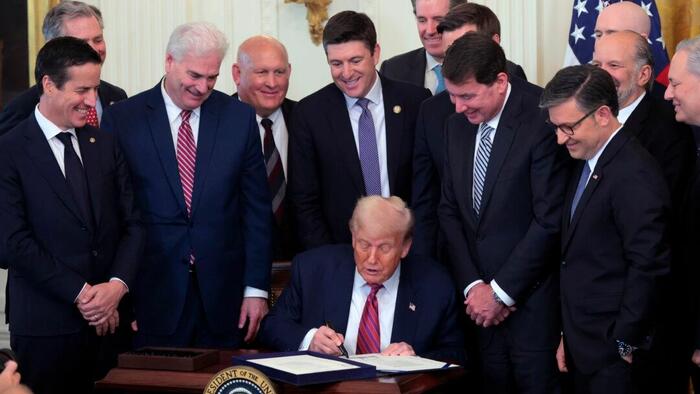


Authored by Naveen Athrappully via The Epoch Times (emphasis ours),
A central bank digital currency (CBDC) will not be allowed in the United States, President Donald Trump said at a White House event on July 18, promising to take legislative action to prevent such a situation.
“I also remain fully committed to my pledge, never to allow the creation of a central bank digital currency in America,” Trump said. “My first week in office, I signed an executive order to ban the creation of a CBDC in the United States. And very soon, I look forward to signing legislation that will codify and make it a permanent law.”
Trump’s comments came amid the signing of the Guiding and Establishing National Innovation for U.S. Stablecoins (GENIUS) Act into law.
During a campaign event in January last year, Trump had said that once he became president, “I will never allow the creation of a central bank digital currency. Such a currency would give the federal government absolute control of your money,” which would be “a dangerous threat to freedom.”
On Jan. 23 this year, the first week after becoming president, Trump signed the executive order banning CBDCs.
“Agencies are hereby prohibited from undertaking any action to establish, issue, or promote CBDCs within the jurisdiction of the United States or abroad,” the order said.
Globally, various nations are at different stages when it comes to their approach towards CBDCs and introducing such currencies into their economy.
According to a July update from the Central Bank Digital Currency Tracker from the Atlantic Council, of the 137 countries or currency unions tracked by the group, three have already launched a CBDC—Nigeria, Jamaica, and the Bahamas.
Moreover, 49 nations or currency unions are piloting CBDCs, 36 are researching such a currency, and 20 are engaged in the development of such a currency.
In addition, 21 are in an inactive status, while two have canceled launching a central bank digital currency, according to the analysis.
Stablecoins are a type of crypto asset that tracks a reference asset, such as currency or commodities, on a 1:1 basis. For instance, if a stablecoin references the U.S. dollar, the issuer of stablecoins will offer one stablecoin for every dollar.
The GENIUS Act establishes a regulatory framework for stablecoins.
The Act requires stablecoins to have “100 percent reserve backing with liquid assets like U.S. dollars or short-term Treasuries,” according to a July 18 White House Fact Sheet. It also requires issuers of stablecoins to “make monthly, public disclosures of the composition of reserves.”
“Stablecoin issuers must comply with strict marketing rules to protect consumers from deceptive practices. Crucially, they are forbidden from making misleading claims that their stablecoins are backed by the U.S. government, federally insured, or legal tender.”
In case a stablecoin issuer becomes insolvent, the GENIUS Act will prioritize the claims of stablecoin holders over all other creditors, ensuring very strong consumer protection, the Fact Sheet said.
Since stablecoin issuers have to back their assets with U.S. Treasuries and dollars, the GENIUS Act is expected to generate higher demand for U.S. debt and “cement the dollar’s status as the global reserve currency,” according to the White House.
During the White House event, Trump said the Act unleashes the “immense power” of U.S. dollar-backed stablecoins.
“This could be perhaps the greatest revolution in financial technology since the birth of the internet,” the president said.
In addition to boosting demand for U.S. Treasuries, stablecoins can also bring down interest rates, according to Trump. “This revolution has the potential to supercharge American economic growth and empower billions of people to save and transfer U.S. dollars.”
Crypto czar David Sacks called the passage of the GENIUS Act a “historical legislative achievement,” with stablecoins estimated to create trillions of dollars in demand for U.S. Treasury securities.
Trump’s promotion of stablecoins while opposing CBDCs, despite both being crypto assets, comes from concerns over threats to freedom.
